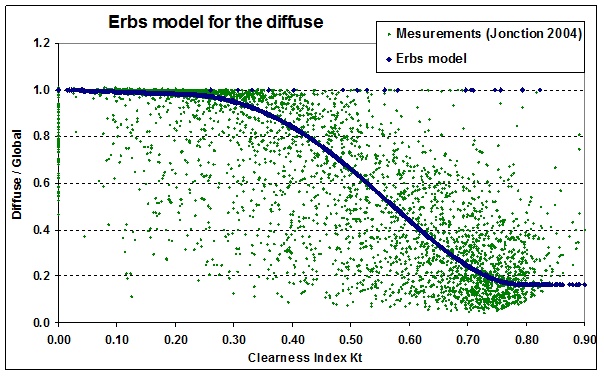Diffuse Irradiance model
When it is not explicitly measured, the diffuse irradiation should be estimated from horizontal global by a model.
We can mention two widely-used models:
- Liu and Jordan's correlation, (Liu and Jordan, 19601), which results from an experimental correlation of the D/G ratio with respect to the clearness index Kt.
- Perez model (Perez, Ineichen et al., 19922), is a more sophisticated model taking hourly data sequence into account.
In PVsyst the diffuse irradiation uses a "Liu and Jordan-like" model which is the Erbs correlation (Erbs et al, 19823). When applied to our data from the SIG (the only simultaneous measurement of global and diffuse irradiations we have at our disposal), this correlation gives good results with an MBE of 1.7% and a RMSE of 27% (with respect to the value of the diffuse irradiance), or 13% (referred to global irradiance).
Note
The most sophisticated model of Perez-Ineichen has also been tested, but does not give significantly better results. From the opinion of one of the authors (P. Ineichen in our laboratory, who has also evaluated the Liu-Jordan correlation) this is especially suited for very well-measured data. Applying it to synthetic hourly data doesn't make great sense. This is the reason why we didn't implement it in the current version. Nevertheless we intend to offer it as an option it in a further version.
-
Benjamin Y.H. Liu and Richard C. Jordan. The interrelationship and characteristic distribution of direct, diffuse and total solar radiation. Solar Energy, 4(3):1–19, July 1960. doi:10.1016/0038-092x(60)90062-1. ↩
-
Richard Perez, Pierre Ineichen, E.L. Maxwell, R.D. Seals, and A. Zelenka. Dynamic global-to-direct irradiance conversion models. ASHRAE Transactions, 98:354–369, 01 1992. ↩
-
D.G. Erbs, S.A. Klein, and J.A. Duffie. Estimation of the diffuse radiation fraction for hourly, daily and monthly-average global radiation. Solar Energy, 28(4):293–302, 1982. doi:10.1016/0038-092x(82)90302-4. ↩
